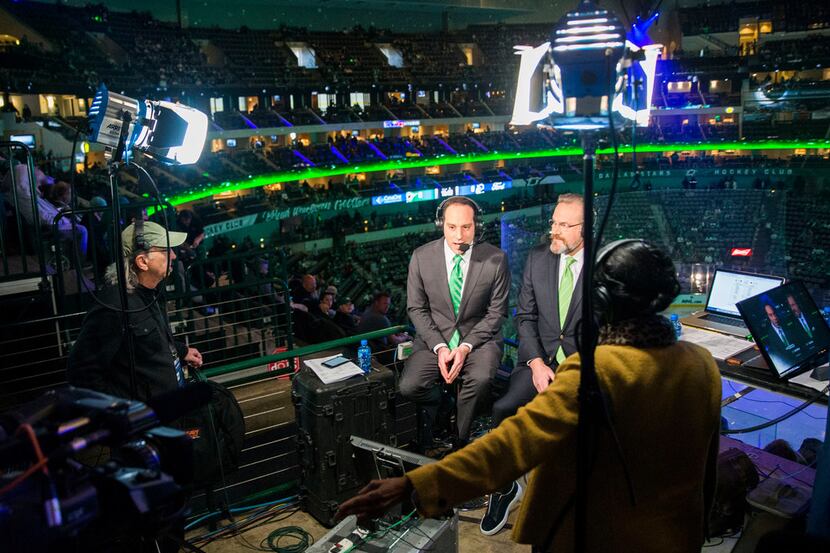Two thousand miles southeast of Rogers Place in Edmonton, in a converted office in Las Colinas, Josh Bogorad and Daryl “Razor” Reaugh are surrounded by televisions. There are individual 65-inch monitors in front of each of them. There are additional ones showing high-angle shots of the Alberta playing surface.
In the 9 or 10 feet between the Fox Sports Southwest broadcasters rest seven Emmys, while bright white lights illuminate their faces for the cameras perched on top of their monitors. It’s an odd setup (into which no one else is allowed to keep it safe) for the Stars’ play-by-play announcer and color commentator, necessitated by the coronavirus pandemic and the NHL’s rules limiting the number of people allowed in its bubbles in Toronto and Edmonton.
It’s also the setup that will serve as the conduit between the Stars on the ice in Edmonton and the fans in Dallas. FSSW is the only way Dallas-Fort Worth area fans can watch the Stars when their round-robin games begin Monday.
"I feel like I'm trying to pick out a monitor at Best Buy or something. I'm looking for a flat screen."
— FOX Sports Southwest (@FOXSportsSW) July 30, 2020
We're mighty happy to have @JoshBogorad and @Razor5Hole back on the call 😂 @DallasStars | #GoStars pic.twitter.com/ODJgF1adsZ
The Stars begin round robin play Monday on FSSW against Vegas at 5:30 p.m., and will play Colorado on FSSW Plus on Wednesday at 5:30 p.m. FSSW will carry at least three first-round games.
Being stationed in North Texas brings a variety of challenges for the Stars broadcasters and the production team. Bogorad and Reaugh are calling the game off of monitors in their new studio, something Bogorad said he’d done only previously for auditions and promotional items. FSSW has little control over the camera angles or the replays on the screen, since a “world feed” is being produced by Sportsnet from Edmonton.
“It’s a blind date,” Reaugh said in a text message. “You’re really excited, probably overly chatty, but also filled with awkward long pauses, and you don’t know how or where things are going to go.”
The world feed is not a new development in the world of sports, but it hasn’t been used as widely across American sports. During World Cups or Olympics, one feed is produced onsite and then distributed around the world, as announcers for different outlets then call the game like normal and broadcasts use their own graphics and sound effects.
But typically during a season, each broadcast team will have many camera angles from which to choose and can pick which replays to show fans. That allows each outlet to cater their story telling to their home audience and take advantage of their announcers’ ability to break down plays, something that Reaugh has specialized in for decades in Dallas.
“Razor has his work cut out for having to follow the storyline that’s being presented on TV by the director, which they don’t have a lot of control over,” FSSW executive producer Jason Walsh said. “And trying to follow the replay sequences that he hasn’t been able to talk to his producer about because the producer hasn’t been told what’s coming.
“It’s just coming, and you’ve got to follow. As Razor likes to say when we get into situations like this, we’re doing radio for TV.”
Mark Vittorio, who directs Stars games on FSSW, said they have control over one camera in Edmonton, meaning he can instruct the camera operator what to shoot and when. This can come in handy during stoppages of play, when Reaugh wants to spotlight a certain player or topic.
“If we want to talk about Jamie Benn or Tyler Seguin, I’ll have that ability, so I’ll get off the world feed,” Vittorio said. “We’re pretty much at the mercy of how the world feed wants to handle replays for the most part.”
But the broadcast also has to deal with a four-second delay on images reaching Las Colinas, which can make it tougher to cater the picture to the audio. Here’s a scenario: The broadcast is talking about a save that Ben Bishop made and wants a close up of the goalie.
“He’s going to be mentioning that [play] four seconds after what he sees actually happened,” Vittorio said. “And then I’m going to have to ask for it, and then it’s going to come back another four seconds later.”
That process squeezes the already limited time during stoppages (which are typically around 20 seconds), and means an extra layer of planning and communication is needed. It’s obvious that the camera goes to the goal-scorer after goals. But what about other scenarios?
“What do you do on an icing?” Walsh said. “Who does the camera go to? Which side? What story is Razor going to tell? Is he going to talk about the home team or the road team or a specific player?”
Without fans in the arenas, the NHL has decided on a handful of measures that are intended to create a familiar feel. Teams around the league were asked to send the league their goal song (yes, Pantera’s “Puck Off” will be played in Edmonton after a Dallas goal), and other items typically used at home games.
The Stars sent the league three team vs. team animations, one for each of their round-robin opponents in Vegas, Colorado and St. Louis. They sent headshots of the entire roster and coaching staff, three opening videos, and two intermission videos. They sent highlights of Seguin, Benn and Alexander Radulov.
The song played at American Airlines Center before power plays will be heard in Edmonton, as will AAC’s goal horn. Public address announcer Jeff Kovarsky will welcome the teams back to the ice before each period. Anthem singer Celena Rae will sing the American and Canadian national anthems. Fans even sent in videos of themselves chanting “Let’s Go Stars!” and “Dallas! Stars!”
(Vittorio is married to Rae, and helped produce the taped anthems: “We just did it in our living room. The acoustics are good, and we have a piano in there. So we thought it would look nice.” In the case that the Stars play Montreal in the Stanley Cup Final, they will have to send the French version of “O Canada.”)
The NHL is also using crowd noises from EA Sports to inject cheering into a spectator-less arena. During Thursday’s exhibition against Nashville, the league allowed broadcasts to choose whether they wanted a feed with crowd noise or without.
FSSW chose the feed without crowd noise and will continue to do so.
“It’s our stance that sports is the ultimate reality TV show,” Walsh said. “If the reality is that there are no fans, it’s our preference that we don’t fake it. It’s our stance that we are not going to take and augment the broadcast with fake sounds. Now, we can’t control what gets played out on the jumbotron and the arena speakers, we’re going to pick that up no matter what.”
For a play-by-play announcer such as Bogorad, crowd noise can be a powerful storytelling tool on the air. After John Klingberg scored the series-clinching goal against Nashville in Game 6 of the first round last season, Bogorad let the moment breathe, and allowed the fans at AAC to deliver the tale of the moment.
In a sterile Rogers Place, he wouldn’t be able to do that. But it’s not a completely foreign feeling, Bogorad said, because big goals happen all the time on the road.
Benn beat the Oilers in overtime on the road and Seguin beat the Canadiens in Montreal, and both times the broadcast couldn’t count on crowd noise to deliver the message.
“If [Klingberg’s goal] happens at Bridgestone Arena, it’s the same amazing moment, but I promise you that Nashville crowd doesn’t sound the same as they did that night at the American Airlines Center,” Bogorad said.
Glenn Cummins, an associate professor at Texas Tech who has researched sports media, conducted a study in 2018 whether crowd noise affected the audience’s interest in a game. Half of his test group heard a soccer broadcast normally, while the other half heard enhanced crowd noise. He did not test what effect no crowd noise had, since he believed that would not happen.
“As they heard the crowd getting more excited, they rated the competition itself as more exciting,” Cummins said. “Some pretty strong and transparent evidence that we follow those social cues when we’re watching the competition. The response of the people around us has a great influence on how we perceive what’s happening on the field.”
Cummins also said he recognized the desire to not artificially add noise to current broadcasts.
“We’re going to look back years from now and say ‘Hey, do you remember that season where the NBA played at Disney World and there was nobody in the stands?’” Cummins said. “And to artificially manipulate that is a violation of this important historical event.”
It’s just one more abnormality for FSSW and its Stars broadcast.
“We anticipate Dallas Stars hockey to look like it always has,” Walsh said, “as much is within our control.”

